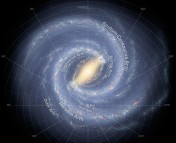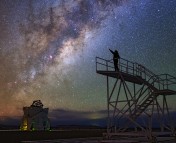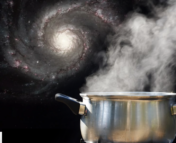Authors: Vinicius M. Placco, Felipe Almeida-Fernandes, Erika M. Holmbeck, Ian U. Roederer, Mohammad K. Mardini, Christian R. Hayes, Kim Venn, Kristin Chiboucas et. al.
First Author’s Institution: NSF’s NOIRLab, Tucson, AZ 85719, USA
Status: Accepted to the Astrophysical Journal [open access]
Have you ever looked at the periodic table and wondered where all the elements come from? Nearly all of the hydrogen, helium, and some of the lithium present in the universe were formed in the first three minutes after the Big Bang. Beyond that, most of the elements (called metals by astronomers) were created from nuclear reactions that take place in the heart of stars. Until iron, the formation processes happened systematically, where heavier elements were formed from the fusion of lighter elements. Beyond iron, about half of the elements are created by a slow and gradual process of capturing neutrons (called s-process, with s for slow).
Elements beyond iron are primarily unstable and can only be created by an extreme event, such as a dying, exploding star (see Figure 1 for an overview). Such cataclysmic events would cause neutrons to rapidly bombard a less heavy nucleus, forming heavier elements. This rapid capture of neutrons is called the r-process (with r for rapid). There is a constant exchange of elements between the stars and the gas surrounding them. This eventually leads to the formation of more stars, setting up different generations of stars.

Studying the s and r processes, in particular, can give us valuable insights into the nature and conditions prevalent in the universe when stars form. The s-process elements are believed to originate from low-mass stars as they evolve throughout their lifetime. For the r-process elements, the events have to be more dramatic, such as supernova or neutron star mergers. The mechanism of r-process elements is determined mainly by modeling, as direct observational evidence of such events is rare.
If we obtain high-resolution spectroscopy of a star and map the abundances of all the elements, it would paint a picture of the events that led to its formation. In today’s paper, the authors try to understand how stars were formed in the halo of the Milky Way by recreating the formation scenario based on the fingerprints in the high-resolution spectrum obtained from a star in the Milky Way halo.
Recreating the formation scenario
The chemical abundances are determined from absorption features in the star’s spectrum. If a particular element is present, it will absorb the starlight passing through the cold gas at a characteristic wavelength, and the extent of absorption can be used to determine how much of the element is present in the star. Looking at the abundances of the lighter elements (Atomic number, Z<38), they showed signs of being poor in iron (Z=26) but having enhanced heavier elements (26<Z<38)[compared to the standard values measured from the Sun]. This would not be the case if the star had formed from a single gas cloud, as the chemical reactions would have proceeded in a linear fraction. This indicates the star formed from a gas cloud polluted by two distinct populations in a multi-enriched process.
The abundances of the heavier elements indicate that the primary process involved in the formation is the r-process. This is not uncommon for old stars in the galactic halo. The s-process elements are formed from the death of low-mass stars, which would not have occurred when such old stars were formed in the halo. Most elements in halo stars are created through the r-process, even those typically formed by s-processes. However, they found that certain elements, such as strontium, do not agree with the predicted values from either an r-process or s-process (Figure 2). Other elements, such as barium, are overproduced, indicating contributions from both s and r processes. They also found an overabundance of thorium (actinide boost process), which could indicate a possible contribution from a separate r-process event. Thus, this star is metal-poor with enhanced heavy elements produced by r-process events.

Modeling the formation scenarios predicts that the lighter elements were likely produced by a low-mass (11.3-13.4 M☉), metal-free star that exploded with low energies, a characteristic property of older Population III stars. The values of mass and energy don’t agree with the expected progenitor population from stars with similar carbon abundances. The heavier elements were likely formed from the merger of two neutron stars with masses of 1.66 and 1.27 M☉, indicating that at least two progenitor populations enriched the star.
Mysterious circumstances prevail

The authors derived the star’s kinematic properties (such as orbital dynamics, velocities, etc.), displayed in Figure 3. They found that the proposed formation scenario and the derived kinematics do not connect it with any known structure in the Milky Way. This highlights that a distinct star formation mechanism may occur in the galactic halo. We must continue studying similar stars with high-resolution spectroscopy to help us understand the formation of old stars in the Milky Way halo.
Astrobite edited by Roel Lefever
Featured image credit: NASA, ESA, and A. Feild [STScI]




